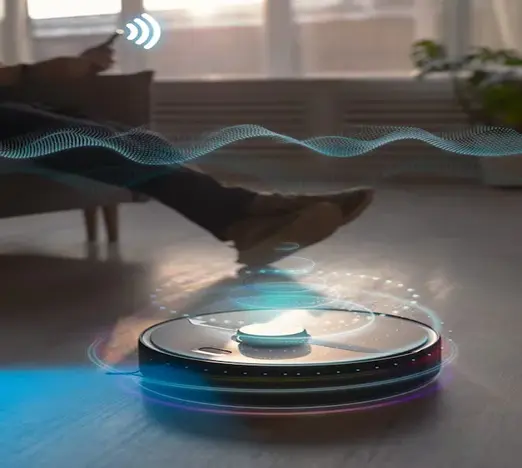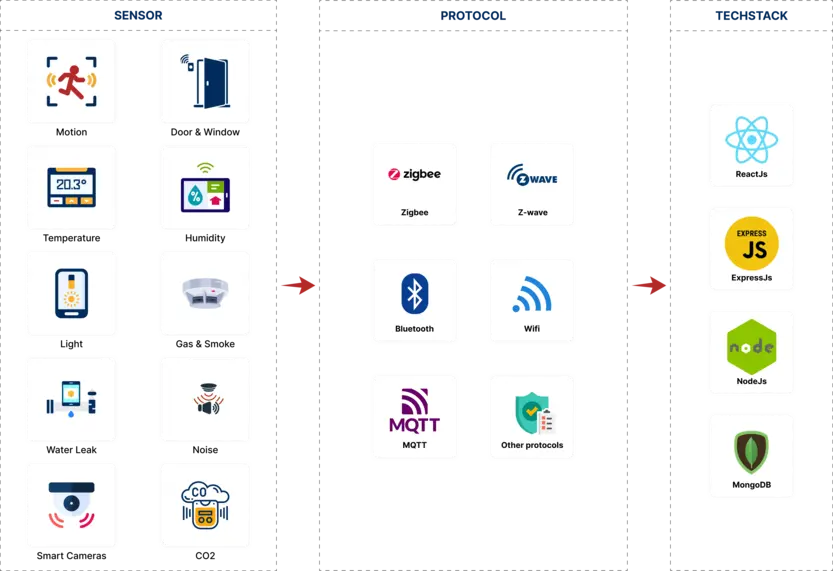










































A Smart Building is a structure that uses advanced technology and integrated systems to enhance its overall performance, efficiency, and functionality. The goal of a Smart Building is to optimize various aspects of its operations, such as energy usage, security, comfort, and maintenance. Key components of a Smart Building typically include:


By harnessing data analytics and real-time insights, Smart Building solutions provide a holistic view of building operations, allowing facility managers to make informed decisions for optimizing energy consumption, reducing costs, and enhancing occupant comfort.

Predictive maintenance uses real-time data to forecast equipment failures and optimize service schedules. It ensures continuous building operations by monitoring critical systems and identifying potential issues before they lead to breakdowns, reducing downtime and costs.

Air quality monitoring tracks indoor air pollutants such as CO2, VOCs, and particulate matter to ensure healthy indoor environments. Real-time data helps adjust ventilation and filtration systems, improving occupant health and maintaining air quality standards.

HVAC systems maintain optimal indoor temperature and air quality by controlling heating, cooling, and ventilation. These systems are monitored in real time to ensure efficiency, comfort, and operational health, with automated adjustments based on occupancy and environmental conditions.

Energy management optimizes energy consumption by monitoring usage patterns and identifying inefficiencies across the building. It tracks power usage, suggests energy-saving strategies, and integrates with renewable sources for sustainable operations, reducing energy costs and environmental impact.

Light monitoring ensures efficient use of lighting systems by tracking energy consumption and occupancy. Automated controls adjust lighting levels based on natural light availability and usage patterns, reducing energy waste and improving the building’s energy efficiency

Water management involves monitoring and controlling water usage to prevent leaks and optimize consumption. By tracking flow rates, water quality, and detecting abnormalities, the system helps reduce waste, lower costs, and ensure sustainable water usage throughout the building.

Occupancy management tracks the movement and presence of people in various areas of the building. It helps optimize space utilization, adjust energy consumption like lighting and HVAC, and ensures comfort by adapting systems based on real-time occupancy data.

Parking management streamlines the allocation and monitoring of parking spaces. It provides real-time availability data, guides drivers to open spots, and integrates with security systems, improving efficiency, reducing congestion, and enhancing the user experience.

Elevator management ensures the smooth and efficient operation of elevator systems by monitoring performance, usage patterns, and faults. Automated adjustments improve travel efficiency and reduce wait times, enhancing both energy efficiency and user experience.

Waste management automates waste collection and disposal processes, ensuring timely removal and tracking of waste generation. It integrates recycling and sustainability initiatives, helping to reduce the building’s environmental footprint and improve efficiency.

Fire safety management includes monitoring smoke detectors, fire alarms, and sprinkler systems. It ensures real-time alerts in case of emergencies and integrates evacuation protocols to safeguard occupants and minimize damage in the event of a fire.

Security and surveillance systems use cameras, sensors, and access controls to monitor building premises in real-time. They ensure safety by detecting unauthorized access, alerting security personnel, and integrating with emergency response systems for prompt action.

Renewable energy integration enables buildings to use solar, wind, or other renewable sources for power. It monitors energy generation and consumption, ensuring a balance between renewable and traditional energy sources to maximize sustainability and reduce reliance on the grid.

Building access control manages the entry and exit of people within the facility using ID cards, biometrics, or keypads. It ensures secure access to restricted areas, tracks movements, and integrates with security systems to prevent unauthorized entry and enhance safety.

Emergency response and evacuation systems provide real-time guidance during emergencies such as fires or security threats. They integrate with alarms and sensors to direct occupants safely to exits, improving response times and ensuring the well-being of everyone in the building.

Asset tracking monitors the location and condition of critical equipment and resources within the building. Using RFID, GPS, or IoT sensors, it ensures valuable assets are accounted for, secured, and properly maintained, enhancing operational efficiency and preventing loss.

Smart metering involves real-time monitoring of utility consumption like electricity, gas, and water. It provides detailed usage data, allowing for accurate billing, energy optimization, and efficient resource allocation, while supporting sustainability goals.

Health and wellness monitoring tracks environmental factors like air quality, lighting, and temperature to promote occupant well-being. It integrates data on noise levels, ergonomics, and comfort to create a healthier, more productive indoor environment for occupants.

Benefit from our 19 years of IoT experience. Get the best smart building solutions tailored to your specific business needs.
Smart Buildings optimize energy usage through intelligent control systems, reducing overall consumption and operational costs by automatically adjusting lighting, HVAC, and other systems based on real-time data and occupancy patterns.
The efficient use of resources, predictive maintenance, and automated systems contribute to cost savings in terms of energy bills, maintenance expenses, and operational efficiency. Smart Buildings often offer a strong return on investment over time.
Integrated systems enable personalized control of the building environment, providing occupants with a comfortable and productive workspace. Smart buildings can adjust lighting, temperature, and other factors to meet individual preferences and needs.
Smart Buildings deploy advanced security systems, such as access control, surveillance, and intrusion detection, enhancing the safety of occupants and assets. In emergency situations, automated systems can facilitate faster response times and coordinated evacuation procedures.
By incorporating sustainable features like renewable energy sources, efficient waste management, and water conservation measures, Smart Buildings contribute to a reduced environmental footprint. This aligns with global efforts to promote sustainability.
Smart building solutions play a vital role in optimizing industrial facilities for energy efficiency, worker safety, and production quality. IoT sensors can monitor equipment performance and environmental conditions, enabling predictive maintenance and minimizing down time. Additionally, smart lighting and ventilation systems can create safe and productive working environments for employees.
Smart building solutions can optimize energy usage, reduce operational costs, and improve space utilization in commercial properties. Building owners and property managers can remotely monitor and control building systems, such as HVAC, lighting, and security, leading to lower maintenance costs and higher tenant satisfaction.
In retail, smart building solutions can enhance the shopping experience by adjusting lighting and climate control to create a comfortable environment for customers. Additionally, smart sensors can collect data on foot traffic and customer behavior, enabling retailers to optimize store layouts and product placements.
Smart building technologies can improve patient care and operational efficiency in healthcare facilities. For example, sensors can monitor environmental conditions to maintain optimal levels of temperature and humidity for patient comfort and infection control. Additionally, real-time location systems (RTLS) can track medical equipment and personnel, reducing time spent searching for resources.
Smart buildings in educational institutions can enhance learning environments and reduce energy consumption. Automated lighting and climate control systems can create comfortable classrooms while optimizing energy usage based on occupancy schedules. Furthermore, smart building analytics can identify opportunities for resource conservation and operational improvements.
Hotels and resorts can use smart building solutions to personalize guest experiences and improve operational efficiency. For instance, smart thermostats and lighting systems can adjust room settings based on guest preferences and occupancy, while integrated property management systems streamline check-in processes and maintenance requests.
Optimized Technologies Inc. is a trusted IoT and Generative AI solutions provider, delivering secure, scalable, and end-to-end services for enterprises. Our deep expertise in device connectivity, data integration, and AI application design enables organizations to unlock actionable insights and automation. We build solutions with enterprise-grade security and cloud-ready scalability, ensuring performance and compliance at every stage. From consultation to deployment and continuous optimization, we provide complete lifecycle support tailored to business needs. With a proven track record across industries, we empower businesses to achieve digital transformation, enhance efficiency, and stay competitive in the era of AI and IoT.